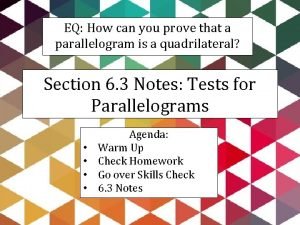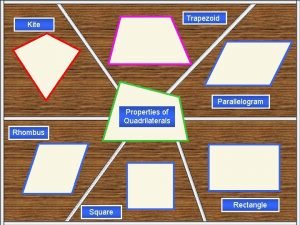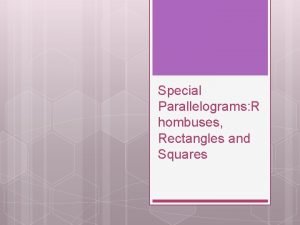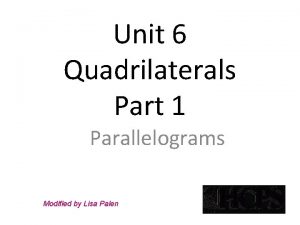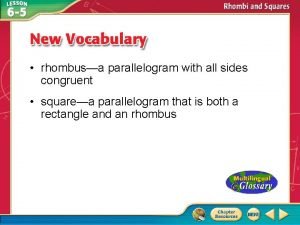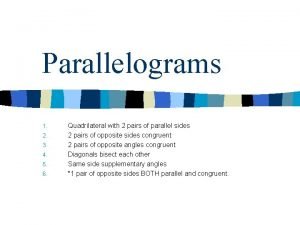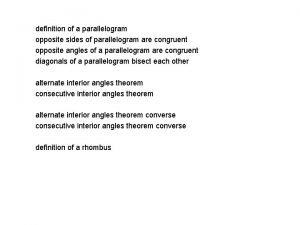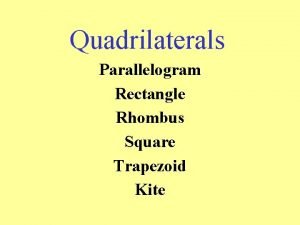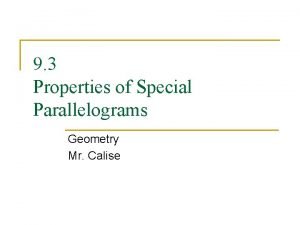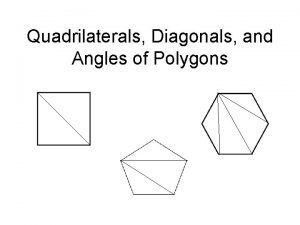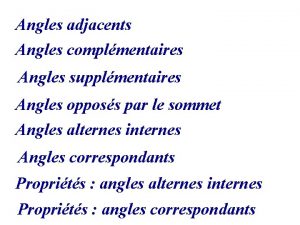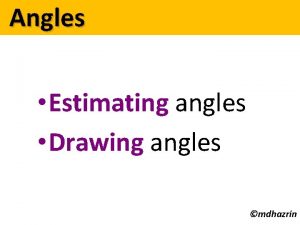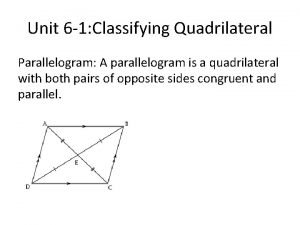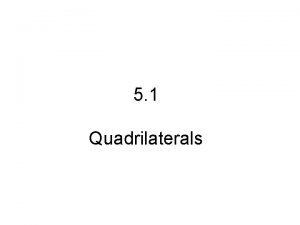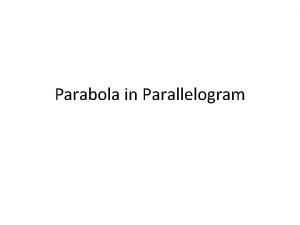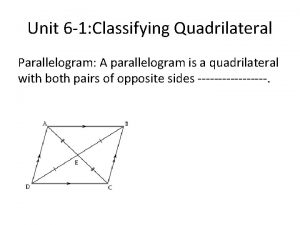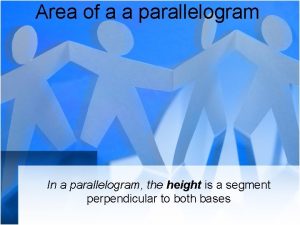Properties of parallelogram Sides Angles Diagonals Theorem A












- Slides: 12

Properties of parallelogram Sides ? Angles ? Diagonals ?

Theorem �A diagonal of a parallelogram divides it into two congruent triangles C D A Diagonal ? B Triangles ?

Proof �Given : AC is a diagonal of the parallelogram ABCD �To prove: ΔABC ≡ ΔCDA �Proof : In ΔABC and ΔCDA D C ∟BCA =∟DAC (Why? ) ∟BAC =∟DCA (Why? ) AC = CA (Why? ) A B ΔABC ≡ ΔCDA (ASA)-proved The diagonal AC divides parallelogram ABCD into two congruent triangles ABC and CDA

Property -1 (Theorem 8. 2) �In a parallelogram opposite sides are equal C D A B �In parallelogram ABCD �AB =DC �BC=AD

Property -2 (Theorem 8. 4) �In a parallelogram opposite angles are equal C D A �In parallelogram ABCD �∟A = ∟C �∟B = ∟D B

Property -3 (Theorem 8. 6) �The diagonals of a parallelogram bisect each other C D O A B �The diagonals AC and BD bisect each other at O, then �OA= OC �OB = OD

Question �What are the conditions for a quadrilateral to become a parallelogram? �A quadrilateral is a parallelogram 1) If each pair of opposite sides are equal 2) If each pair of opposite angles are equal 3) If the diagonals of the quadrilateral bisect each other

Another Condition (Theorem 8. 8) �A Quadrilateral is a parallelogram if a pair of its opposite sides is equal and parallel C D A B �ABCD is a parallelogram if AB = DC and AB II DC �Or ( if AD=BC and ABIIBC )

Conditions ? �A quadrilateral is a parallelogram 1) If each pair of opposite sides are equal 2) If each pair of opposite angles are equal 3) If the diagonals of the quadrilateral bisect each other 4) If a pair of opposite side is equal and parallel

Midpoint theorem (Theorem 8. 9) �The line segment joining the midpoints of any two sides of a triangle is parallel to the third side A E B �If E and F are midpoints of sides AB and AC of triangle ABC , then EF II BC F C

Converse of midpoint theorem ( 8. 10) �The line drawn through the midpoint of one side of a triangle, parallel to another side bisects the third side A E B F C �If E is the midpoint of AB and EF II BC then F is the mid point of AC (i. e. AF =FC )

Summary � A diagonal of a parallelogram divides it into two congruent triangles � In a parallelogram opposite sides are equal. � In a parallelogram opposite angles are equal. �The diagonals of a parallelogram bisect each other. �A Quadrilateral is a parallelogram if a pair of its opposite sides is equal and parallel � The line segment joining the midpoints of any two sides of a triangle is parallel to the third side �The line drawn through the midpoint of one side of a triangle, parallel to another side bisects the third side
 Parallelogram diagonals converse
Parallelogram diagonals converse Is a rectangle a trapezoid
Is a rectangle a trapezoid Angles - vertically opposite angles and missing angles
Angles - vertically opposite angles and missing angles Rhombus special parallelogram
Rhombus special parallelogram Stokes theorem gives relationship between
Stokes theorem gives relationship between Proving the parallelogram side theorem
Proving the parallelogram side theorem Rhombusa
Rhombusa All rhombuses are parallelograms
All rhombuses are parallelograms In a parallelogram opposite sides are
In a parallelogram opposite sides are Angles of a convex polygon
Angles of a convex polygon Diagram for the relationship among quadrilaterals
Diagram for the relationship among quadrilaterals Special parallelograms
Special parallelograms What is congruent in math
What is congruent in math
